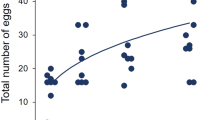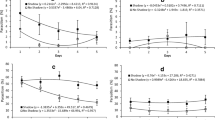Abstract
Larval survival of plum curculios (PCs),Conotrachelus nenuphar (Herbst), was found to decrease with increasing egg density per fruit. Subsequently, we assayed PCs for propensity to avoid egg-laying at sites (immature plums) already occupied by conspecific eggs. Laboratory choice tests showed PCs made an equal number of visits to and ovipositions in fruit with a single oviposition as in clean fruit. Although there was a trend toward more visits to fruit which contained four or eight oviposition wounds and eggs or eight artificial punctures than to clean fruit, PCs oviposited less frequently into these than clean fruit. Results suggest that wounding of fruit may enhance the ability of ovipositing PCs to locate fruit, but at the same time may furnish cues allowing some degree of discrimination against heavily infested fruit for oviposition.
Similar content being viewed by others
References
Faeth, S.H. 1985. Host leaf selection by leafminers: Interaction among trophic levels.Ecology 66:870–875.
Finch, S. 1980. Chemical attraction of plant-feeding insects to plants, pp. 67–143,in Coaker, T.H. (ed.). Applied Biology, Vol. 5. Academic Press, New York.
Girolami, V., Vianello, A., Strapazzon, A., Ragazzi, E., andVeronese, G. 1981. Ovipositional deterrents inDacus oleae.Entomol. Exp, Appl. 19:177–188.
Jacklin, S.W., Yonce, C.E., andHollon, J.P. 1968. Crowding effects on plum curculio reared at several densities on two sizes of green apples.J. Econ. Entomol. 61:816–819.
Kennedy, J.S. 1978. The concepts of olfactory “arrestment” and “attraction.”Physiol. Entomol. 3:91–98.
Kozlowski, M.W., Lux, S., andDmoch, J. 1984. Oviposition behavior and pod marking in the cabbage seed weevil,Ceutorhynchus assimilis.Entomol. Exp. Appl. 34:277–282.
Levine, E., andDyHall, F.R. 1977. Effect of feeding and oviposition by the plum curculio on apple and plum fruit abscission.J. Econ. Entomol. 70:603–607.
Miller, P.L. 1979. A possible sensory function for the stop-go patterns of running in phorid flies.Physiol. Entomol. 4:361–370.
Mitchell, E.R., andHeath, R.R. 1985. Influence ofAmaranthus hybridus (L.) allelochemicais on oviposition behavior ofSpodoptera exigua andS. eridania (Lepidoptera: Noctuidae).J. Chem. Ecol. 11:609–617.
Owens, E.D., Hauschild, K.L, Hubbell, G.L., andProkopy, R.J. 1982. Diurnal behavior of plum curculio (Coleoptera: Curculionidae) adults within host trees in nature.Ann. Entomol. Soc. Am. 75:357–362.
Price, P.W., Bouton, C.E., Grass, P., Mcpheron, B.A., Thompson, J.N., andWeis, A.E. 1980. Interactions among three trophic levels: Influence of plants on interactions between insect herbivores and natural enemies.Annu. Rev. Ecol. Syst. 11:41–65.
Prokopy, R.J. 1972. Evidence for a marking pheromone deterring repeated oviposition in apple maggot flies.Environ. Entomol. 1:326–332.
Prokopy, R.J. 1981. Epideictic pheromones influencing spacing patterns of phytophagous insects, pp. 181–213, in D.A. Nordlund, R.L. Jones, and W.L. Lewis, (eds.). Semiochemicals: Their Role in Pest Control. Wiley, New York.
Prokopy, R.J., Roitberg, B.D., andAverill, A.L. 1984. Resource Partitioning, pp. 301–330,in W.J. Bell and R.T. Cardé (eds.). Chemical Ecology of Insects. Chapman and Hall, London.
Quaintance, A.L., andJenne, E.L. 1912. The plum curculio.U.S. Dept. Agric. Bur. Entomol. Bull. 103:13–155.
Renwick, J.A.A., andRadke, C.D. 1981. Host plant constituents as oviposition deterrents for the cabbage looper,Trichoplusia ni. Entamai.Exp. Appl. 30:201–204.
Renwick, J.A.A., andRadke, C.D. 1985. Constituents of host and non-host plants deterring oviposition by the cabbage butterfly,Pieris rapae.Entomol. Exp. Appl. 39:21–26.
Roitberg, B.D., andProkopy, R.J. 1982. Resource assessment by adult and larval codling moths.N.Y. Entomol. Soc. 90:258–265.
Roitberg, B.D., andProkopy, R.J. 1984. Host discrimination by adult and larval European apple sawfliesHoplocampa testudinea (Klug) (Hymenoptera: Tenthredinidae).Environ. Entomol. 13:1000–1003.
Rothschild, M., andSchoonhoven, L.M. 1977. Assessment of egg load byPieris brassicae (Lepidoptera: Pieridae).Nature 266:352–355.
Saxena, K.N., andBasit, A. 1982. Inhibition of oviposition by volatiles of certain plants and chemicals in the leafhopperAmrasca devastans (Distant).J. Chem. Ecol. 8:329–339.
Shorey, H.H. 1973. Behavioral responses to insect pheromones.Annu. Rev. Entomol. 18:349–380.
Sokal, R.R., andRohlf, F.J. 1981. Biometry. W.H. Freeman, New York.
Stansly, P.A., andCate, J.R. 1984. Discrimination by ovipositing boll weevils (Coleoptera: Curculionidae) against previously infestedHampea (Malvaceae) flower buds.Environ. Entomol. 13:1361–1365.
Author information
Authors and Affiliations
Rights and permissions
About this article
Cite this article
Butkewich, S.L., Prokopy, R.J. & Green, T.A. Discrimination of occupied host fruit by plum curculio females (Coleoptera: Curculionidae). J Chem Ecol 13, 1833–1841 (1987). https://doi.org/10.1007/BF01013232
Received:
Accepted:
Issue Date:
DOI: https://doi.org/10.1007/BF01013232




